Network Theory and Switching Behaviors: A User Guide for Analyzing Electronic Records Databases
Abstract
1. Introduction
1.1. Getting Data from an Electronic Records Database
1.2. The Importance of Investigating Drug-Switching Behaviors
1.3. The Statistical Analysis of Drug-Switching Behavior
2. Fundamentals of Graph Theory
3. From Electronic Records Databases to Adjacency Matrix
4. A Working Example
5. Discussion and Conclusions
Author Contributions
Funding
Data Availability Statement
Acknowledgments
Conflicts of Interest
Appendix A
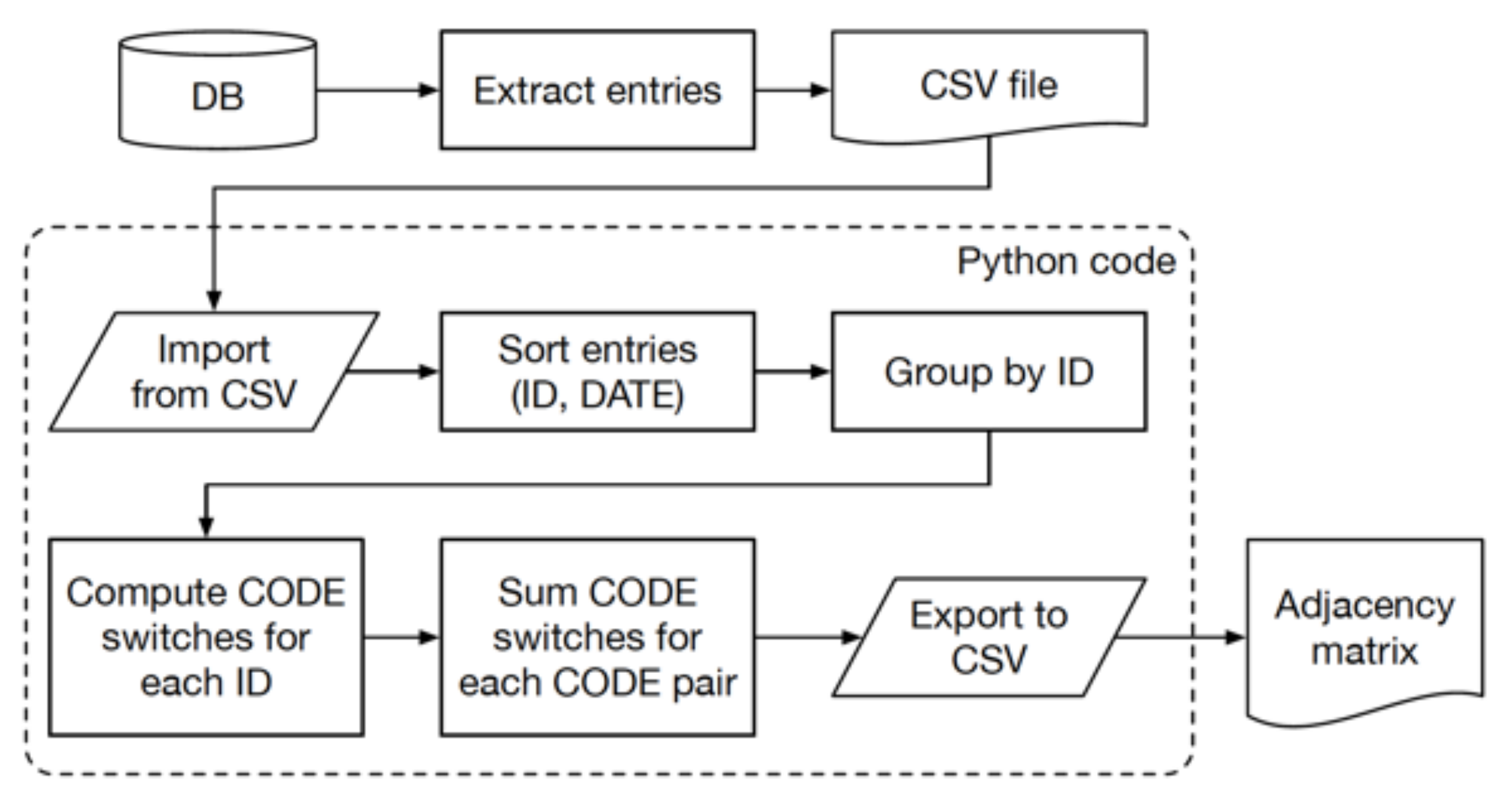
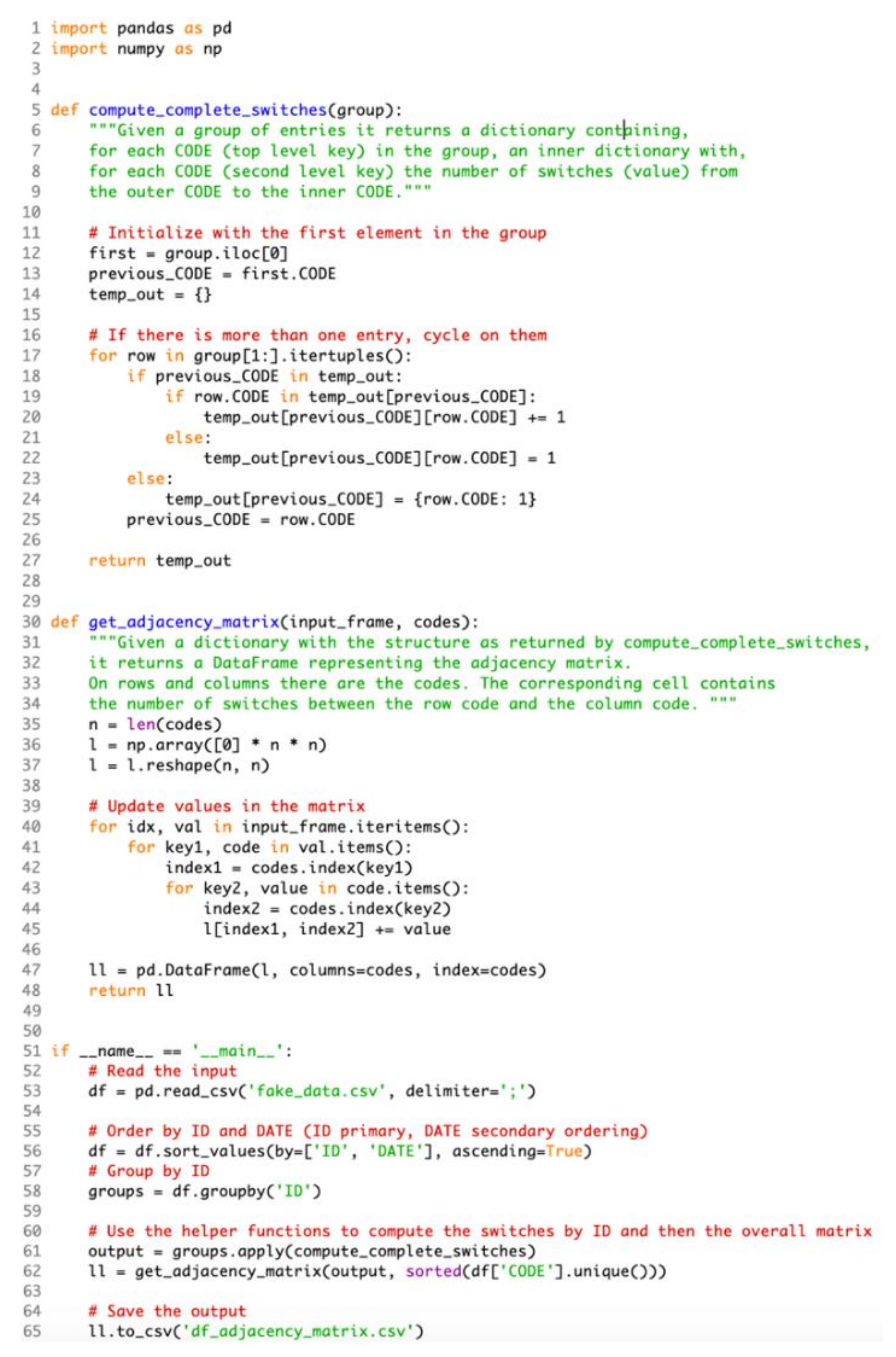
Appendix B
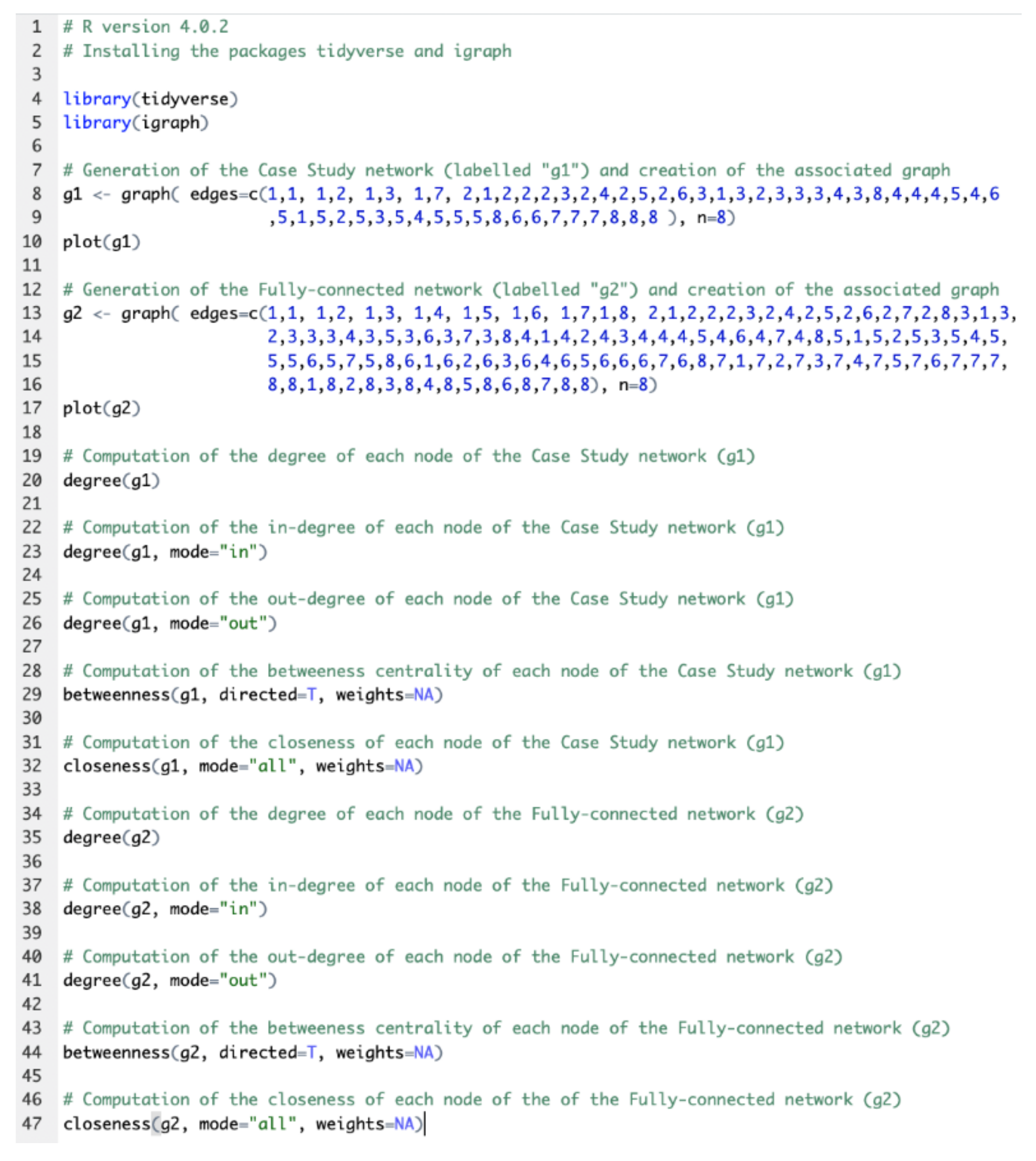
References
- Barsocchi, P.; Cimino, M.G.; Ferro, E.; Lazzeri, A.; Palumbo, F.; Vaglini, G. Monitoring elderly behavior via indoor position-based stigmergy. Pervasive Mob. Comput. 2015, 23, 26–42. [Google Scholar] [CrossRef]
- Watanabe, Y.; Hirano, Y.; Asami, Y.; Okada, M.; Fujita, K. A unique database for gathering data from a mobile app and medical prescription software: A useful data source to collect and analyse patient-reported outcomes of depression and anxiety symptoms. Int. J. Psychiatry Clin. Pract. 2017, 21, 318–321. [Google Scholar] [CrossRef] [PubMed]
- Guazzini, A.; Yoneki, E.; Gronchi, G. Cognitive dissonance and social influence effects on preference judgments: An eye tracking based system for their automatic assessment. Int. J. Hum. Comput. Stud. 2015, 73, 12–18. [Google Scholar] [CrossRef]
- Giudici, F.; Cavalli, T.; Giusti, F.; Gronchi, G.; Batignani, G.; Tonelli, F.; Brandi, M.L. Natural history of MEN1 GEP-NET: Single-center experience after a long follow-up. World J. Surg. 2017, 41, 2312–2323. [Google Scholar] [CrossRef] [PubMed]
- Cianferotti, L.; Parri, S.; Gronchi, G.; Marcucci, G.; Cipriani, C.; Pepe, J.; Raglianti, M.; Minisola, S.; Brandi, M.L. Affiliations expand Prevalence of chronic hypoparathyroidism in a Mediterranean region as estimated by the analysis of anonymous healthcare database. Calcif. Tissue Int. 2018, 103, 144–150. [Google Scholar] [CrossRef] [PubMed]
- Vannucci, L.; Masi, L.; Gronchi, G.; Fossi, C.; Carossino, A.M.; Brandi, M.L. Calcium intake, bone mineral density, and fragility fractures: Evidence from an Italian outpatient population. Arch. Osteoporos. 2017, 12, 40. [Google Scholar] [CrossRef]
- Jha, A.K.; DesRoches, C.M.; Campbell, E.G.; Donelan, K.; Rao, S.R.; Ferris, T.G.; Shields, A.; Rosenbaum, S.; Blumenthal, D. Use of electronic health records in US hospitals. N. Engl. J. Med. 2009, 360, 1628–1638. [Google Scholar] [CrossRef] [PubMed]
- Baldacci, F.; Policardo, L.; Rossi, S.; Ulivelli, M.; Ramat, S.; Grassi, E.; Palumbo, P.; Giovannelli, F.; Cincotta, M.; Ceravolo, R.; et al. Reliability of administrative data for the identification of Parkinson’s disease cohorts. Neurol. Sci. 2015, 36, 783–786. [Google Scholar] [CrossRef] [PubMed]
- Shao, Y.; Durmus, N.; Zhang, Y.; Pehlivan, S.; Fernandez-Beros, M.-E.; Umana, L.; Corona, R.; Addessi, A.; Abbott, S.A.; Smyth-Giambanco, S.; et al. The Development of a WTC Environmental Health Center Pan-Cancer Database. Int. J. Environ. Res. Public Health 2021, 18, 1646. [Google Scholar] [CrossRef]
- Concheiro-Moscoso, P.; Martínez-Martínez, F.J.; Miranda-Duro, M.d.C.; Pousada, T.; Nieto-Riveiro, L.; Groba, B.; Mejuto-Muiño, F.J.; Pereira, J. Study Protocol on the Validation of the Quality of Sleep Data from Xiaomi Domestic Wristbands. Int. J. Environ. Res. Public Health 2021, 18, 1106. [Google Scholar] [CrossRef]
- Wu, M.-H.; Li, C.-Y.; Pan, H.; Lin, Y.-C. The Relationship between Scabies and Stroke: A Population-Based Nationwide Study. Int. J. Environ. Res. Public Health 2019, 16, 3491. [Google Scholar] [CrossRef] [PubMed]
- Gronchi, G. The Use of Network Theory for Analyzing Switching Behaviors: Assessing Cognitive and Educational-Based Intervention for Promoting Health. Front. Psychol. 2018, 9, 1095. [Google Scholar] [CrossRef]
- Hennessy, S. Use of health care databases in pharmacoepidemiology. Basic Clin. Pharmacol. Toxicol. 2006, 98, 311–313. [Google Scholar] [CrossRef] [PubMed]
- Demotes-Mainard, J.; Cornu, C.; Guérin, A.; Bertoye, P.H.; Boidin, R.; Bureau, S.; Chrétien, J.M.; Delval, C.; Deplanque, D.; Dubray, C.; et al. How the new European data protection regulation affects clinical research and recommendations? Therapies 2019, 74, 31–42. [Google Scholar] [CrossRef]
- Puljak, L.; Mladinić, A.; Iphofen, R.; Koporc, Z. Before and after enforcement of GDPR: Personal data protection requests received by Croatian Personal Data Protection Agency from academic and research institutions. Biochem. Med. 2020, 30, 363–370. [Google Scholar] [CrossRef]
- Kanwal, T.; Anjum, A.; Khan, A. Privacy preservation in e-health cloud: Taxonomy, privacy requirements, feasibility analysis, and opportunities. Clust. Comput. 2021, 24, 293–317. [Google Scholar] [CrossRef]
- Raikwar, M.; Gligoroski, D.; Kralevska, K. SoK of used cryptography in blockchain. IEEE Access 2019, 7, 148550–148575. [Google Scholar] [CrossRef]
- Hasselgren, A.; Rensaa, J.A.H.; Kralevska, K.; Gligoroski, D.; Faxvaag, A. Blockchain for Increased Trust in Virtual Health Care: Proof-of-Concept Study. J. Med. Internet Res. 2021, 23, e28496. [Google Scholar] [CrossRef]
- Hasselgren, A.; Wan, P.K.; Horn, M.; Kralevska, K.; Gligoroski, D.; Faxvaag, A. GDPR Compliance for Blockchain Applications in Healthcare. In Proceedings of the International Conference on Big Data, IOT and Blockchain (BIBC 2020), Dubai, United Arab Emirates, 24–25 October 2020. [Google Scholar]
- Cianferotti, L.; Parri, S.; Gronchi, G.; Rizzuti, C.; Fossi, C.; Black, D.M.; Brandi, M.L. Changing patterns of prescription in vitamin D supplementation in adults: Analysis of a regional dataset. Osteoporos. Int. 2015, 26, 2695–2702. [Google Scholar] [CrossRef]
- Ingrasciotta, Y.; Bertuccio, M.P.; Crisafulli, S.; Ientile, V.; Muscianisi, M.; L’Abbate, L.; Pastorello, M.; Provenzano, V.; Scorsone, A.; Scondotto, S.; et al. Real World Use of Antidiabetic Drugs in the Years 2011–2017: A Population-Based Study from Southern Italy. Int. J. Environ. Res. Public Health 2020, 17, 9514. [Google Scholar] [CrossRef]
- Bounoure, F.; Mouly, D.; Beaudeau, P.; Bentayeb, M.; Chesneau, J.; Jones, G.; Skiba, M.; Lahiani-Skiba, M.; Galey, C. Syndromic Surveillance of Acute Gastroenteritis Using the French Health Insurance Database: Discriminatory Algorithm and Drug Prescription Practices Evaluations. Int. J. Environ. Res. Public Health 2020, 17, 4301. [Google Scholar] [CrossRef] [PubMed]
- Glerum, P.J.; Maliepaard, M.; de Valk, V.; Burger, D.M.; Neef, K. Drug switching in The Netherlands: A cohort study of 20 active substances. BMC Health Serv. Res. 2020, 20, 1–10. [Google Scholar] [CrossRef] [PubMed]
- Glerum, P.J.; Neef, C.; Burger, D.M.; Yu, Y.; Maliepaard, M. Pharmacokinetics and Generic Drug Switching: A Regulator’s View. Clin. Pharmacokinet. 2020, 59, 1065–1069. [Google Scholar] [CrossRef] [PubMed]
- Langman, M.; Kahler, K.H.; Kong, S.X.; Zhang, Q.; Finch, E.; Bentkover, J.D.; Stewart, E.J. Drug switching patterns among patients taking non-steroidal anti-inflammatory drugs: A retrospective cohort study of a general practitioners database in the United Kingdom. Pharmacoepidemiol. Drug Saf. 2001, 10, 517–524. [Google Scholar] [CrossRef] [PubMed]
- Linton, D.; Procyshyn, R.M.; Elbe, D.; Lee, L.H.N.; Barr, B.M. A retrospective study of antipsychotic drug switching in a pediatric population. BMC Psychiatry 2013, 13, 248. [Google Scholar] [CrossRef] [PubMed]
- Keks, N.; Schwartz, D.; Hope, J. Stopping and switching antipsychotic drugs. Aust. Prescr. 2019, 42, 152–157. [Google Scholar] [CrossRef]
- Fishbein, M.; Ajzen, I. Theory-based behavior change interventions: Comments on Hobbis and Sutton. J. Health Psychol. 2005, 10, 27–31. [Google Scholar] [CrossRef] [PubMed]
- Fjeldsoe, B.S.; Marshall, A.L.; Miller, Y.D. Behavior change interventions delivered by mobile telephone short-message service. Am. J. Prev. Med. 2009, 36, 165–173. [Google Scholar] [CrossRef]
- Abraham, C.; Michie, S. A taxonomy of behavior change techniques used in interventions. Health Psychol. 2008, 27, 379–387. [Google Scholar] [CrossRef] [PubMed]
- Steinmetz, H.; Knappstein, M.; Ajzen, I.; Schmidt, P.; Kabst, R. How effective are behavior change interventions based on the theory of planned behavior? A three-level meta-analysis. Z. Psychol. 2016, 224, 216–233. [Google Scholar]
- Room, J.; Hannink, E.; Dawes, H.; Barker, K. What interventions are used to improve exercise adherence in older people and what behavioural techniques are they based on? A systematic review. BMJ Open 2017, 7, e019221. [Google Scholar] [CrossRef]
- Kini, V.; Ho, P.M. Interventions to improve medication adherence: A review. JAMA 2018, 320, 2461–2473. [Google Scholar] [CrossRef] [PubMed]
- Helson, H. Studies of Anomalous Contrast and Assimilation. J. Opt. Soc. Am. 1963, 53, 179–184. [Google Scholar] [CrossRef]
- Higgins, E.T.; Lurie, L. Context, categorization, and recall: The “change-of-standard” effect. Cogn. Psychol. 1983, 15, 525–547. [Google Scholar] [CrossRef]
- Righi, S.; Gronchi, G.; Marzi, T.; Rebai, M.; Viggiano, M.P. You are that smiling guy I met at the party! Socially positive signals foster memory for identities and contexts. Acta Psychol. 2015, 159, 1–7. [Google Scholar] [CrossRef]
- Pierguidi, L.; Righi, S.; Gronchi, G.; Marzi, T.; Caharel, S.; Giovannelli, F.; Viggiano, M.P. Emotional contexts modulate intentional memory suppression of neutral faces: Insights from ERPs. Int. J. Psychophysiol. 2016, 106, 1–13. [Google Scholar] [CrossRef] [PubMed]
- Kenrick, D.T.; Gutierres, S.E. Contrast effects and judgments of physical attractiveness: When beauty becomes a social problem. J. Pers. Soc. Psychol. 1980, 38, 131–140. [Google Scholar] [CrossRef]
- Takemura, K. The effect of decision frame and decision justification on risky choice. Jpn. Psychol. Res. 1993, 35, 36–40. [Google Scholar] [CrossRef][Green Version]
- De Martino, B.; Kumaran, D.; Seymour, B.; Dolan, R.J. Frames, biases, and rational decision-making in the human brain. Science 2006, 313, 684–687. [Google Scholar] [CrossRef]
- Levi, H.R.; Jackson, R.C. Contextual factors influencing decision making: Perceptions of professional soccer players. Psychol. Sport Exerc. 2018, 37, 19–25. [Google Scholar] [CrossRef]
- Tracy, C.S.; Dantas, G.C.; Moineddin, R.; Upshur, R.E. Contextual factors in clinical decision making: National survey of Canadian family physicians. Can. Fam. Physician 2005, 51, 1106–1107. [Google Scholar] [PubMed]
- Thaler, R.H.; Sunstein, C.R. Nudge: Improving Decisions about Health, Wealth, and Happiness. Theory; Penguin Books: London, UK, 2008. [Google Scholar]
- Gronchi, G.; Giovannelli, F. Dual process theory of thought and default mode network: A possible neural foundation of fast thinking. Front. Psychol. 2018, 9, 1237. [Google Scholar] [CrossRef] [PubMed]
- Sloman, S.A. The empirical case for two systems of reasoning. Psychol. Bull. 1996, 119, 3–22. [Google Scholar] [CrossRef]
- Evans, J.S.B. In two minds: Dual-process accounts of reasoning. Trends Cogn. Sci. 2003, 7, 454–459. [Google Scholar] [CrossRef]
- Osman, M. An evaluation of dual-process theories of reasoning. Psychon. Bull. Rev. 2004, 11, 988–1010. [Google Scholar] [CrossRef] [PubMed]
- Andermann, F.; Duh, M.S.; Gosselin, A.; Paradis, P.E. Compulsory generic switching of antiepileptic drugs: High switchback rates to branded compounds compared with other drug classes. Epilepsia 2007, 48, 464–469. [Google Scholar] [CrossRef] [PubMed]
- Kesselheim, A.S.; Misono, A.S.; Lee, J.L.; Stedman, M.R.; Brookhart, M.A.; Choudhry, N.K.; Shrank, W.H. Clinical equivalence of generic and brand-name drugs used in cardiovascular disease: A systematic review and meta-analysis. JAMA 2008, 300, 2514–2526. [Google Scholar] [CrossRef]
- Saag, M.S.; Powderly, W.G.; Schambelan, M.; Benson, C.A.; Carr, A.; Currier, J.S.; Dubé, M.P.; Gerber, J.G.; Grinspoon, S.K.; Grunfeld, G.; et al. Switching antiretroviral drugs for treatment of metabolic complications in HIV-1 infection: Summary of selected trials. Top. HIV Med. 2002, 10, 47–51. [Google Scholar]
- Ideguchi, H.; Ohno, S.; Takase, K.; Ueda, A.; Ishigatsubo, Y. Outcomes after switching from one bisphosphonatesphosphonate to another in 146 patients at a single university hospital. Osteopor. Int. 2008, 19, 1777–1783. [Google Scholar] [CrossRef]
- Martin, B.C.; Wiley-Exley, E.K.; Richards, S.; Domino, M.E.; Carey, T.S.; Sleath, B.L. Contrasting measures of adherence with simple drug use, medication switching, and therapeutic duplication. Ann. Pharmacother. 2009, 43, 36–44. [Google Scholar] [CrossRef]
- Kolaczyk, E.D.; Csárdi, G. Statistical Analysis of Network Data with R; Springer: New York, NY, USA, 2014; Volume 65. [Google Scholar]
- Luke, D.A. A User’s Guide to Network Analysis in R; Springer: London, UK, 2015. [Google Scholar]
- Iacobucci, D.; Henderson, G.; Marcati, A.; Chang, J. Network analyses of brand switching behavior. Int. J. Res. Mark. 1996, 13, 415–429. [Google Scholar] [CrossRef]
- Hansen, D.L.; Shneiderman, B.; Smith, M.A.; Himelboim, I. Social network analysis: Measuring, mapping, and modeling collections of connections. In Analyzing Social Media Networks with NodeXL; Morgan Kaufmann: Burlington, MA, USA, 2011; pp. 31–51. [Google Scholar]
- Palla, G.; Derényi, I.; Farkas, I.; Vicsek, T. Uncovering the overlapping community structure of complex networks in nature and society. Nature 2005, 435, 814–818. [Google Scholar] [CrossRef] [PubMed]
- R Core Team. R: A Language and Environment for Statistical Computing; R Foundation for Statistical Computing: Vienna, Austria, 2020; Available online: https://www.R-project.org/ (accessed on 29 August 2021).
- Wickham, H.; Averick, M.; Bryan1, J.; Chang, W.; D’Agostino McGowan, L.; François, R.; Grolemund, G.; Hayes, A.; Henry, L.; Hester, J. Welcome to the tidyverse. J. Open Source Soft. 2019, 4, 1686. [Google Scholar] [CrossRef]
- Csardi, G.; Nepusz, T. The igraph software package for complex network research. J. Complex Syst. 2006, 1695, 1–9. [Google Scholar]
- Ganguli, R. Rationale and strategies for switching antipsychotics. Am. J. Health Syst. Pharm. 2002, 59, S22–S26. [Google Scholar] [CrossRef]
- Thiebaud, P.; Patel, B.V.; Nichol, M.B.; Berenbeim, D.M. The effect of switching on compliance and persistence: The case of statin treatment. Am. J. Manag. Care 2005, 11, 670–674. [Google Scholar]
- Bellingeri, M.; Bevacqua, D.; Scotognella, F.; Alfieri, R.; Cassi, D. A Comparative Analysis of Link Removal Strategies in Real Complex Weighted Networks. Sci. Rep. 2020, 10, 3911. [Google Scholar] [CrossRef] [PubMed]
- Bellingeri, M.; Bevacqua, D.; Scotognella, F.; Cassi, D. The Heterogeneity in Link Weights May Decrease the Robustness of Real-World Complex Weighted Networks. Sci. Rep. 2019, 9, 10692. [Google Scholar] [CrossRef]
- Rodriguez, M.Z.; Comin, C.H.; Casanova, D.; Bruno, O.M.; Amancio, D.R.; Costa, L.D.F.; Rodrigues, F.A. Clustering algorithms: A comparative approach. PLoS ONE 2019, 14, e0210236. [Google Scholar] [CrossRef]
- Gronchi, G.; Guazzini, A.; Massaro, E.; Bagnoli, F. Mapping cortical functions with a local community detection algorithm. J. Complex Netw. 2014, 2, 637–653. [Google Scholar] [CrossRef]
- Vannucci, L.; Fossi, C.; Quattrini, S.; Guasti, L.; Pampaloni, B.; Gronchi, G.; Giusti, F.; Romagnoli, C.; Cianferotti, L.; Marcucci, G.; et al. Calcium intake in bone health: A focus on calcium-rich mineral waters. Nutrients 2018, 10, 1930. [Google Scholar] [CrossRef]
- Vlaev, I.; King, D.; Dolan, P.; Darzi, A. The theory and practice of “nudging”: Changing health behaviors. Public Adm. Rev. 2016, 76, 550–561. [Google Scholar] [CrossRef]
- Palermo, S.; Giovannelli, F.; Bartoli, M.; Amanzio, M. Are Patients with Schizophrenia Spectrum Disorders More Prone to Manifest Nocebo-Like-Effects? A Meta-Analysis of Adverse Events in Placebo Groups of Double-Blind Antipsychotic Trials. Front. Pharmacol. 2019, 10, 502. [Google Scholar] [CrossRef] [PubMed]
- Zaccara, G.; Giovannelli, F.; Schmidt, D. Placebo and nocebo responses in drug trials of epilepsy. Epilepsy Behav. 2015, 43, 128–134. [Google Scholar] [CrossRef] [PubMed]
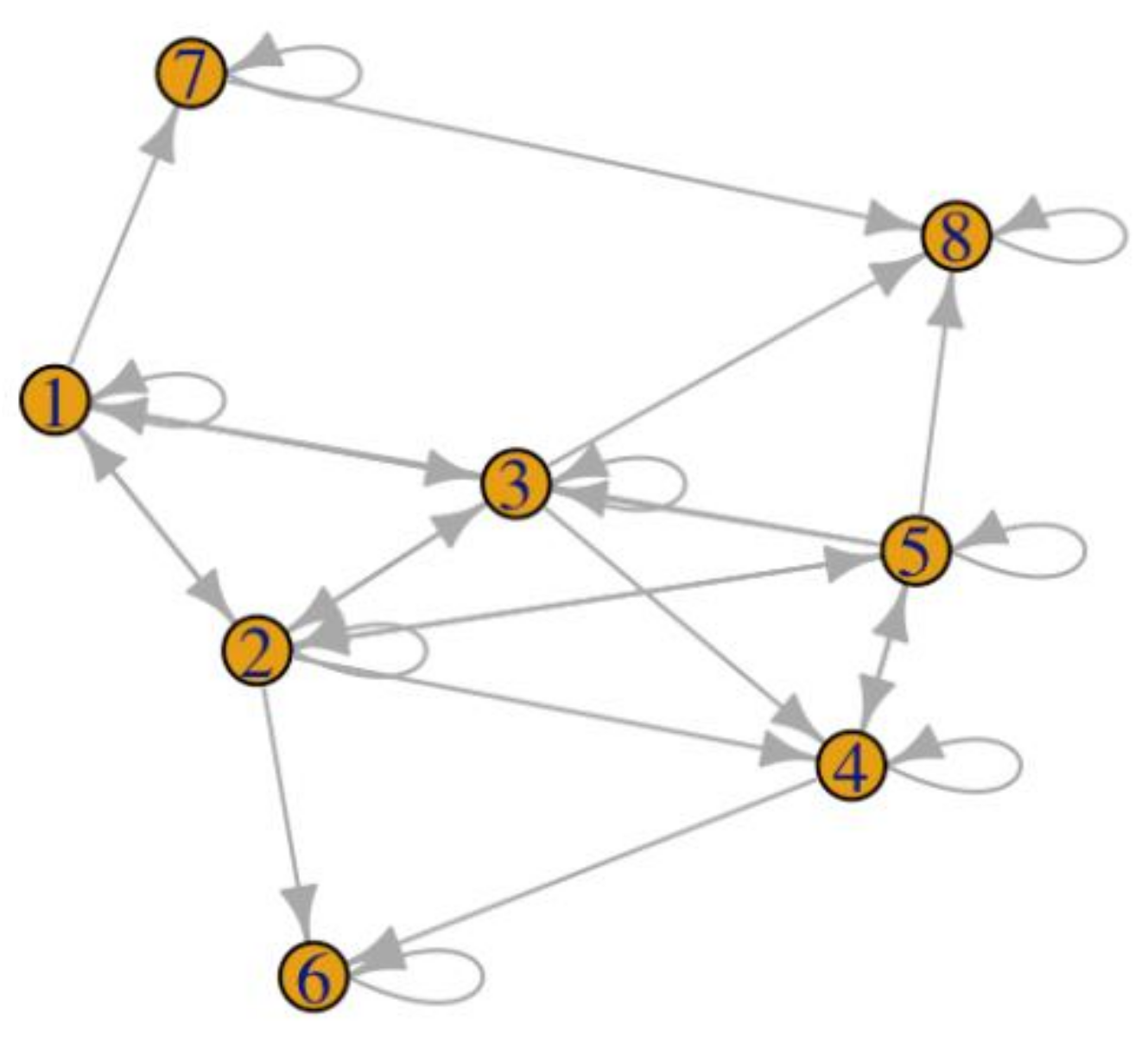
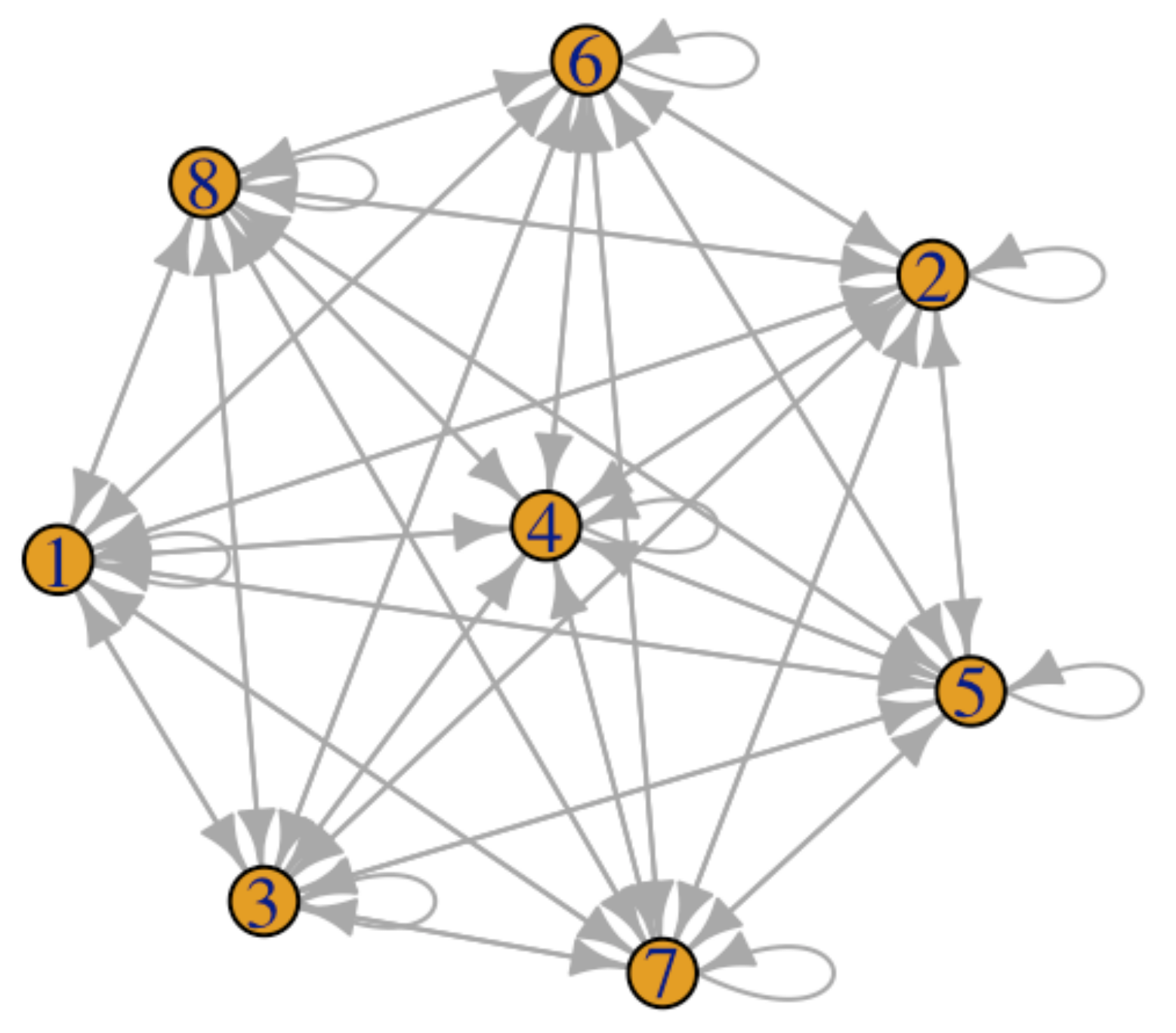
| ID | DATE | CODE |
|---|---|---|
| 1002 | 12/10/2020 | 1 |
| 2043 | 12/10/2020 | 1 |
| 2005 | 12/10/2020 | 2 |
| 1002 | 13/10/2020 | 3 |
| 4345 | 13/10/2020 | 1 |
| … | … | … |
| Case Study | Fully Connected Network | |||||||||
|---|---|---|---|---|---|---|---|---|---|---|
| Drug | Degree | In-Degree | Out-Degree | Betweenness Centrality | Closeness | Degree | In-Degree | Out-Degree | Betweenness Centrality | Closeness |
| 1 | 8 | 4 | 4 | 4.00 | 0.10 | 16 | 8 | 8 | 0 | 0.14 |
| 2 | 10 | 4 | 6 | 4.00 | 0.11 | 16 | 8 | 8 | 0 | 0.14 |
| 3 | 9 | 4 | 5 | 1.50 | 0.11 | 16 | 8 | 8 | 0 | 0.14 |
| 4 | 7 | 4 | 3 | 1.50 | 0.09 | 16 | 8 | 8 | 0 | 0.14 |
| 5 | 9 | 3 | 6 | 5.50 | 0.11 | 16 | 8 | 8 | 0 | 0.14 |
| 6 | 4 | 3 | 1 | 0.00 | 0.07 | 16 | 8 | 8 | 0 | 0.14 |
| 7 | 4 | 2 | 2 | 0.50 | 0.07 | 16 | 8 | 8 | 0 | 0.14 |
| 8 | 5 | 4 | 1 | 0.00 | 0.08 | 16 | 8 | 8 | 0 | 0.14 |
Publisher’s Note: MDPI stays neutral with regard to jurisdictional claims in published maps and institutional affiliations. |
© 2021 by the authors. Licensee MDPI, Basel, Switzerland. This article is an open access article distributed under the terms and conditions of the Creative Commons Attribution (CC BY) license (https://creativecommons.org/licenses/by/4.0/).
Share and Cite
Gronchi, G.; Raglianti, M.; Giovannelli, F. Network Theory and Switching Behaviors: A User Guide for Analyzing Electronic Records Databases. Future Internet 2021, 13, 228. https://doi.org/10.3390/fi13090228
Gronchi G, Raglianti M, Giovannelli F. Network Theory and Switching Behaviors: A User Guide for Analyzing Electronic Records Databases. Future Internet. 2021; 13(9):228. https://doi.org/10.3390/fi13090228
Chicago/Turabian StyleGronchi, Giorgio, Marco Raglianti, and Fabio Giovannelli. 2021. "Network Theory and Switching Behaviors: A User Guide for Analyzing Electronic Records Databases" Future Internet 13, no. 9: 228. https://doi.org/10.3390/fi13090228
APA StyleGronchi, G., Raglianti, M., & Giovannelli, F. (2021). Network Theory and Switching Behaviors: A User Guide for Analyzing Electronic Records Databases. Future Internet, 13(9), 228. https://doi.org/10.3390/fi13090228






